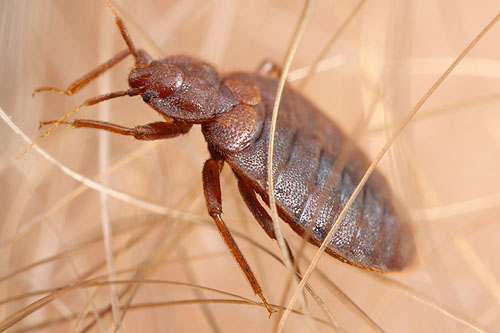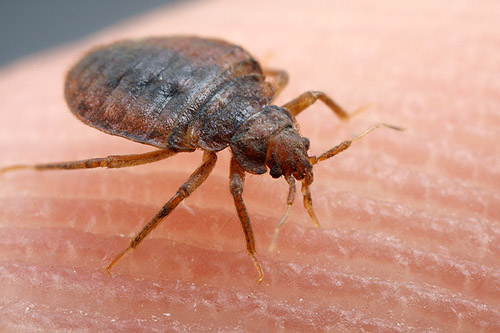Bed bugs are back. The resurgence of these blood-feeding pests is perhaps the biggest entomological story of the past decade. Take a look, for instance, at the Google search volume for "bed bugs" over the past few years:
Why am I telling you all of this?
I've just posted a new online bed bug photo gallery. I was fortunate to get my hands on a vial of live bed bugs recently, and it turns out that the little guys are excellent entomological models. Cute, cuddly, and willing to work with feed from the photographer. I've posted some of the shots below, and the full series is at alexanderwild.com.

Bed bugs have mouthparts of the piercing/sucking kind. Think of a razor-tipped straw. Here, a bug shows how the labium folds back on itself to give the stylets deeper access to the host.

Bed bugs are bigger than many people think: adults can reach 5-6 mm in length and are about the same size and color as an apple seed. Here, a bug navigates a rather hairy host.
Additional bed bug links:
- Bed Bugs photo gallery - more images from the above series
- Bed Bug Biology & Management - Harvard's definitive bed bug guide
- Bed Bug Registry - check your hotel's bed bug history
- Bedbugger.com - the definitive bed bug blog
- Bug Girl blogs about insecticide resistence in bed bugs
- Smithereen Pest Control - Chicago area bed bug specialists and generous providers of the animals pictured above
[An aside to friends and family having second thoughts about visiting the myrmecos household after reading this post: Let me reassure you that these images were NOT taken anywhere near home. The bugs were photographed in a controlled lab environment, and each individual was accounted for and pickled in ethanol following the photo session.]








I noticed that your adult bedbug hasn't had a blood meal. It would be cool if you took a backlit image of one that had just fed.
Yeah, I agree. That's one of those great ideas that comes up *after* I've already pickled the specimens.
Really amazing photos!
Thanks for linking to Bedbugger also!
Fantastic blog Alex - enjoyed the article and the photographs were stunning.
I'm just guessing here, but given the excellence of the pictures, coupled with the sort of things that people do searches for, I suspect that you may have just written what will become your Most Popular Blog Posting Ever.
Hi Alex,
Great pictures as usual, and I guess letting a bedbug from a lab colony feed on you for the purposes of art isn't as creepy as it first seems. Last I read bedbugs were not considered important vectors in the field (or rather, in the habitation), but in lab tests they have the capability to transfer some nasty pathogens, so letting wild-caught bedbugs feed on you isn't the best idea in the world.
When I took Insect Taxonomy thirty years ago or so, bedbugs were impossible to find - even in flop house mattresses. I had to make do with a batbug for my collection. Now it seems it is the rare dormitory that doesn't have them. I think I prefer the old days in this instance.
Fascinating... Beautiful and intriguing images, although I'm not sure I share your enthusiasm for letting them nibble your tender bits during the photo session. Yet I have to admit that made for some fantastic views!
There was a article published recently about a study conducted by UMAS, that Bed Bugs have developed resistant to pesticides commonly used by Pest Control Operators and Exterminators. More info please login here www.xerobugs.wordpress.com
[itches]
I glad you put that disclaimer in a bit worrying Alex.
Thanks for the great/creepy photos. I'd like to post a link from my blog http://bedbugsnorthwest.wordpress.com/.
The Great Northwest is having it's own little epidemic, but folks aren't quite talking about it yet. Soon!
Tarra Byte
Alex; Looks like you were down nose to nose with these bugs.
Very nice photos!
It's much better when you can take them voluntarily out of a vial rather than steal yourself for taking scans or photos of them while you are infested.
Oh, I really like the use of the google traffic data to make your point. Great idea! (and great shots, but that goes without saying :)
Nice photos and beautiful detail, what kind of camera do you have?
Just a hint, they like to feed at dawn.
If you let them bite you, it may cause a reaction causing welts and the scratching may become unbearable. One lady in New York had to be hospitalized due to the reaction.